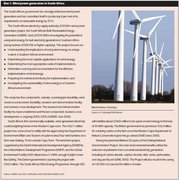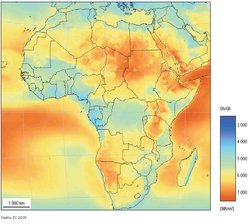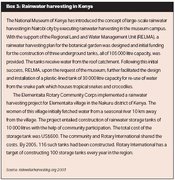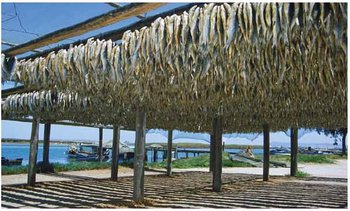Endowment opportunities from atmospheric resources in Africa
Contents
Endowment opportunities
Atmospheric resources offer important opportunities for sustainable development and improving human well-being. Their sustainable management can contribute towards the realization of the Millennium Development Goals (MDGs) and meeting the MDG targets, as well as regional and national targets:
- Rainwater harvesting can increase access to safe and clean water;
- Effective rain-fed agriculture can improve food security and thus reduce extreme hunger;
- Harnessing renewable energy resources can power small-scale rural industries and improve income;
- Developing national renewable energy resources can enhance reliability and lower costs of electricity to the productive sectors;
- Harnessing solar energy can improve access to household lighting and power, and increase livelihood and educational opportunities;
- Increasing participation in global businesses and the market sector can lead to improved income and enhance opportunity; and
- Reducing air pollution can result in improved health and reduce child and maternal mortality levels.
Improving scientific and technological capacity, including through partnerships with the global community, is an important strategy for harnessing the full potential of atmospheric resources. Information and knowledge are increasingly driving societies and economies. The success of future societies, businesses and economies will be determined by their abilities to generate, process and make use of knowledge. Thus, harnessing atmospheric resources for sustainable development demands that Africa invest in broadening and strengthening science and technology capacity. Adding value to natural resources requires the development of new materials, processes and products. Advances in materials and biotechnology are crucial for most renewable energy technologies. In the short-term, Africa will have to rely heavily on technology transfer, although in the medium- to long-term, developing indigenous technology will be essential.
Africa can promote innovations through the establishment of science parks. These will serve as seedbeds for new technology-based firms (NTBFs), which could contribute to poverty reduction in the medium- to long-term. In the short-term, African governments could enter into partnerships with scientists in the African diaspora to support research and development in Africa. This strategy will repatriate knowledge and skills to Africa and assist in mitigating the “brain drain”.
Investment in basic research is important for maximizing opportunities. International cooperation, including through establishing partnerships between developing countries, could offer crucial support and access to resources. Cooperation between South Africa, India and Brazil in nanotechnology development is one example for an effective research partnership. Investing in basic research is important, as noted by the International Energy Agency (IEA):
"Developing advanced technologies requires not only applied research and technology refinement, but also the innovation that stems from advances in basic science. Knowledge flowing from basic research is what will feed the development of new materials, bioprocesses, nanotechnologies, and other approaches that could reduce clean technology costs. It could also lead to new unforeseen technologies and novel approaches to providing energy services. Effective linkage between basic science and applied technology development will be important to ensure that these opportunities are opened up".
The availability of fossil fuel energy reserves underpins the wealth of African countries and their ability to invest in the development of renewable energy resources, such as hydropower and solar energy. Oil reserves are found mainly in Algeria, Angola, Chad, Gabon, Mauritania, Equatorial Guinea, Egypt, Nigeria, Libya and Sudan and have been an important factor in improved economic growth . Africa has just 5 percent of the world’s coal resources, and over 97 percent of this is found in South Africa, Mozambique, Zimbabwe and Botswana. Most of the natural gas reserves are found in Western Africa (Nigeria 30.8 percent) and Northern Africa (Egypt 10.7 percent, Algeria 39.6 percent, and Libya 11.5 percent). Countries not endowed with fossil fuel reserves require substantial financial support to develop their atmospheric resources.
Wind energy
 Figure 1: Wind power generation in South Africa (Source: SABRE-Gen 2004, SABCnews 2005, DME-Danida 2005)
Figure 1: Wind power generation in South Africa (Source: SABRE-Gen 2004, SABCnews 2005, DME-Danida 2005) Where good sites are available, wind energy is an option that should be given a chance. Although generation costs vary from site to site, these have come down considerably over the last 15 years and it is estimated that generation costs are equivalent to more traditional energy generation, making wind energy a competitive option. The world potential for wind development is enormous. It is projected that 130 gigawatts (GW) will have been installed globally by the year 2010.
Wind speed and frequency determine how much energy can be produced by wind turbines. Low wind speeds prevail in most of Africa, with average wind speeds of between 3 to 6 meters per second. Despite the average low wind speeds, there are some localized sites with good wind speeds that could be tapped for water pumping and electricity generation. There is potential to generate wind power from 24 percent of Africa’s land – with an estimated gross electrical potential of 106,000 terawatt-hours (TWh), Africa can utilize this potential through the development of community-level systems. Hybrid energy systems, coupling wind turbines with conventional generators, may be used to mitigate the intermittent nature of wind and energy constant energy supply.
African governments should invest in local capacity to plan, design and construct wind plants. Wind towers are site-specific and are best suited for local design and construction. Electrical and electronic components may be sourced from global markets. However, there is a need to standardize these components. Wind power plants are capable of powering small industries in off-grid locations. Governments should harmonize their policies on energy and industry. Partnerships with the private sector as well as with the global community, as envisaged under the World Summit on Sustainable Development (WSSD) Johannesburg Plan of Implementation, are important.
Powering small-scale industries in rural and off-grid areas
Where suitable sites exist, wind presents opportunities for powering small-scale industries, including water pumping. However, investment in local capacity to plan, design and construct wind, biomass and hydro turbine-generator sets is essential to take advantage of this opportunity. Wind towers and hydropower plant civil works are site-specific. Planning, engineering and design costs would be drastically reduced if local personnel undertook these tasks. This is the strategy used by China and India, who are among the world leaders in wind and small hydropower plants.
Development of rural power plants should be encouraged to supply power to communities and homes and thus improve livelihood opportunities and human well-being. Investments could target the following:
- Invest in planning and design of plants;
- Standardize key components of plants and produce most of these components in Africa;
- Invest in a large number of small plants to achieve economies of scale;
- Develop computer-based tools and instruments and standardize design of plants; and
- Invest in technology for modern computer-based survey and mapping techniques as a means of lowering design and engineering costs.
Access to electricity in rural areas, transmitted or generated, will contribute to the improvement of the lives of the rural women and children who are forced to spend considerable time in search of firewood and often trek long distances for water and firewood.
Solar radiation
The availability of solar resources is not a factor undermining its potential use; instead, there are three factors determining uptake: the availability of efficient and low-cost technologies to convert solar energy into electricity and hydrogen, effective energy storage technologies, and high efficiency end-use technologies.
Concentrating solar power
 Figure 1: Solar radiation distribution in Africa. (Source: EC 2005)
Figure 1: Solar radiation distribution in Africa. (Source: EC 2005) Concentrating solar power systems – or solar thermal energy – provide both heat, such as warming water, and electricity through the use of reflective techniques. These systems are particularly suitable where there is plenty of direct solar irradiation. Concentrating solar power systems have high potential in the arid and semiarid lands (ASAL) of the northern and southern parts of Africa. Concentrating solar power systems are suitable for provision of industrial and commercial power. These systems may replace conventional fossil fuel plants and contribute significantly to environmental conservation. Although they have not been extensively used, these systems are not new to Africa. Egypt has an early and continued interest in this sector. Egypt is one of the few countries in the world that has a government department dedicated to the development of renewable energy sources. Under the direction of the New and Renewable Energy Authority (part of the Ministry of Energy), one of the first solar thermal power plants built since the 1980s will come on line in 2007 at El Koraimat near Cairo, Egypt.
The costs of investing in concentrating solar power systems are relatively high. Investment costs range from US$3,600 to $15,400 per Kilowatt (KW) in places with insolation levels of 1,700 KWh per m2. Generation costs are in the order of US$0.1 to US$0.15 per KWh. Where insolation levels are over 1,700 KWh per m2, as is common in Africa, optimal cost-competitiveness is achievable.
Compared to other renewable energy systems, concentrating solar power systems currently have a low market potential. Global capacity was estimated at 825 Megawatt (MW) in 2005, and was predicted to increase to 2,225 MW by 2010 and to 20,150 MW by 2020. The global energy contribution from these systems stands at over 1 terawatt-hour (TWh), and growth rates of about 20 percent are foreseen. Africa stands to benefit by investing in concentrating solar power systems. Morocco and Egypt have ongoing projects in this area. Morocco is setting up a 30-50 MW plant, while Egypt is working on a 35 MW plant.
Africa needs to build its research and development (R&D) capacity to participate effectively in the fastgrowing concentrating solar power market. The projects in Egypt and Morocco will help accumulate knowledge and experience, and in turn lower engineering and development costs. The Egyptian government has increased interest and incentives for development of electricity supply utilizing renewable energy such as solar power. Two 130 MW solar-supported steam generation power plants are being constructed at Kuraymat in Egypt. One option is to develop capacity and capability to manufacture plant and machinery necessary for power generation. In the short-term, one strategy may be to acquire disembodied technologies from developed countries.
Solar photovoltaic power
Solar photovoltaic (PV) power has the potential to meet the small energy services needs of isolated off-grid communities as it is ideal for lighting, powering electronic equipment and charging of telecommunication equipment. Lighting and small power needs of schools and community health centers may also be met from solar PV. Photovoltaic systems tend to penetrate the market faster when marketed as complete energy service packages like solar lanterns.
The high prices of solar PV equipment have contributed significantly to the low sales and poor adoption. The cost of a PV panel at US$4.7 per Watt (based on retail prices in Nairobi for 40 Watt panels) is prohibitive in comparison to competing fuels like wood, kerosene and gas. These prices will have to come down for this technology to be widely adopted and the benefits of solar energy to be utilized.
Apart from deriving energy services from PV solar generators, there are also business opportunities associated with this sector. This market is growing at 30 percent per year (500 MW per year) and is set to continue growing at this high rate beyond 2010. The capital cost of the PV system has been halving every decade. This trend is expected to continue. This should serve as an incentive for Africa to invest in PV systems.
Solar home systems (SHS) and solar lanterns are ideal for lighting and powering most domestic electrical and electronic equipment. Concerted efforts to achieve widespread adoption of these technologies continue to be hampered by high initial investment costs. For example in 2005, an SHS of 40W, capable of powering an average rural home, costs US$500 in Kenya. The cheapest solar lantern of 11W retails for US$100 in Kenya. These prices are well beyond the reach of the average income in Africa. The cost challenge presents an opportunity for Africa to invest in projects that will reduce the current prices by at least half in the short term. Opportunities for investment in solar PV production, construction and use include:
- Cell assembly into panel modules; cell manufacture requires huge expertise and costly infrastructure and is not a priority for Africa at the moment;
- Research and development to improve on and manufacture batteries in Africa. Some countries like Egypt have already achieved this and others may learn from them;
- Invest in manufacture of inverters and controllers;
- Grid-connected SHS should be encouraged. These systems use the grid for energy storage and eliminate the battery and are ideal for urban homes.
Solar dryers and heaters
Natural solar drying of raw foodstuffs and linen is common in Africa. Direct drying of grains and tubers preserves and prepares food for milling. Solar heat is also used for heating water and space. However, practices and methodologies currently in use do not make maximum use of the available solar heat. Developing indigenous drying and heating solar systems through increasing investment in technology development will create new business opportunities in the manufacturing and marketing sectors.
The potential for solar drying and heating is enormous, particularly in ASAL. Drying food is an important part of the food security strategies of poor communities. There is potential to develop and widely use solar drying systems for the preservation of food. This could contribute to meeting the Millennium Development Goal (MDG) target of reducing the number of people experiencing chronic hunger by 2015. The commercialization of the drying of fish and agricultural products may also increase and diversify income-generating opportunities. This technology may also be used to dry timber and tobacco.
Botswana has implemented several solar heating projects and accumulated experience which other countries can benefit from. The government of Botswana, in partnership with the housing corporation and the mining companies, has installed over 10,000 solar water-heating units. The full potential was not realized because the first generation units did not supply adequate hot water and thus were abandoned by users illustrating the need for a better match between technology and demand.
Enhanced use of natural lighting
Sunlight (Solar radiation) is a natural resource that offers opportunities for sustainable development. Daylight can reduce reliance on artificial lighting during the day and improve indoor ambience where innovative architectural designs are adopted. Investment in architectural technologies and training is critical to harvest these benefits. This would include education and information on available technologies; improving capacity to use computer-aided design in architectural and engineering consultancy; developing and enforcing standards for incorporating environmental concerns in building design; and constructing government demonstration projects.
There are an increasing number of examples globally of how buildings can be designed to benefit from natural light and air flows and reduce energy consumption. In the U.S., the Leadership Energy and Environment Design (LEED) has developed green building standards and these have become widely accepted, with developers of 1,700 buildings seeking certification. All new federal buildings are required to meet minimum LEED standards.
Rainwater
 Figure 1: Boy drinking water from a banana leaf, Nigeria.
Figure 1: Boy drinking water from a banana leaf, Nigeria.(Source: I. Uwanaka/UNEP/Still Pictures)
Relatively few African countries have an average annual rainfall exceeding 1,000 mm. More countries receive an average annual rainfall below 500 mm, and are thus considered to be dry lands. However, despite a history of drought and floods, rainwater has the potential to supply safe water and enhance food security through effective rain-fed agriculture.
Rainwater harvesting
 Figure 2: Rainwater harvesting in Kenya
Figure 2: Rainwater harvesting in Kenya(Source: rainwaterharvesting.org 2003)
Collecting rainwater for drinking, livestock and domestic use is an established practice in Africa. However, traditional collection techniques have become inadequate due to population growth and reduced rainfall. New methods of rainwater harvesting are taking root in Africa; for example, roof catchment and collection in tanks are particularly popular. Plastic or concrete tanks are preferred over metal tanks, as the latter corrode.
Improving the effectiveness of rain-fed agriculture
With the use of appropriate technologies, rainwater could play a bigger role in irrigation and combating the effects of drought. However, appropriate technologies will need to be developed and or acquired, and widely disseminated.
There is growing acknowledgement of the value of rainwater harvesting in rural areas. In Kenya, for example, road runoff catchment, water and farm ponds, sand and sub-surface dams, and conservation tillage have been adopted to increase agricultural production. A nongovernmental organization, Practical Action's (Intermediate Technology Development Group) work in Darfur, western Sudan, is a further example of effective use of rain-fed agriculture. In Darfur, ITDG is supporting the construction of dams across gullies, crescent terraces, shallow wells and channels as appropriate technologies for rainwater harvesting.
Investment in research and development to produce new irrigation systems that use water effectively, particularly in ASAL, should be encouraged. Widespread adoption of low-cost tube irrigation can contribute to poverty alleviation and improve food security and protect against famine. It has, for example, been successfully used in eastern India.
Further Reading
- Bakaya-Kyahurwa, E. and Oladiran, M. T., 2000. Performance of solar water heating systems in Botswana. Journal of Energy in Southern Africa, 11(1).
- Barker, R., van Koppen, B. and Shah, T., 2000. A Global Perspective on Water Scarcity/Poverty: Achievements and Challenges for Water Resource Management. International Water Management Institute, Colombo.
- Center for Science & Environment, 2003. rainwaterharvesting.org
- ECA, 2005. Economic Report on Africa 2005: Meeting the Challenges of Unemployment and Poverty in Africa. Economic Commission for Africa, Addis Ababa.
- EIA, 2003. 8.2 World Estimated Recoverable Coal. Energy Information Administration.
- El-Sayed, M. A. H., 2005. Solar supported steam production for power generation in Egypt. Energy Policy. 33(10):1251-9.
- FAO, 2005. State of the World’s Forests 2005. Food and Agriculture Organization of the United Nations, Rome.
- Greenpeace International, 2005. Greenpeace report proves solar power available to 100 million people by 2025. Press Release, 7 October.
- Gunther, M., 2005. Taking on the Energy Crunch: How Corporate America is working to develop alternatives to oil and gas – and lower its bills. Fortune, 7 February, 151(3), p. 97, 6p, 11c.
- IEA, 2004. Key World Energy Statistics 2004.
- Practical Action (Intermediate Technology Development Group)
- Karekezi, S., 2001. The potential of renewable energy technologies in Africa. Working Paper No. 273,AFREPREN/FWD. African Energy Policy Research Network.
- Lew, D. and Logan, J., 2005. Energizing China’s Wind Power Sector.
- Morthorst, P. E. and Jacobsen, H., 2003. Wind Energy – The Facts, Volume 2: Costs, Prices and Values. European Wind Energy Association.
- Rogner, H., 2000. Chapter 5: Energy Resources. (Endowment opportunities from atmospheric resources in Africa) In World Energy Assessment: Energy and the Challenge of Sustainability (ed. Goldemberg, J.), pp. 135-71. United Nations Development Programme, New York.
- UNEP, 1999. Global Environment Outlook-2000. United Nations Environment Programme, Nairobi.
- UNEP, 2006. Africa Environment Outlook 2
- WEC, 2001. Survey of Energy Resources, 19th Edition. World Energy Coucil, London.
|
|
| Disclaimer: This article is taken wholly from, or contains information that was originally published by, the United Nations Environment Programme. Topic editors and authors for the Encyclopedia of Earth may have edited its content or added new information. The use of information from the United Nations Environment Programme should not be construed as support for or endorsement by that organization for any new information added by EoE personnel, or for any editing of the original content. |
